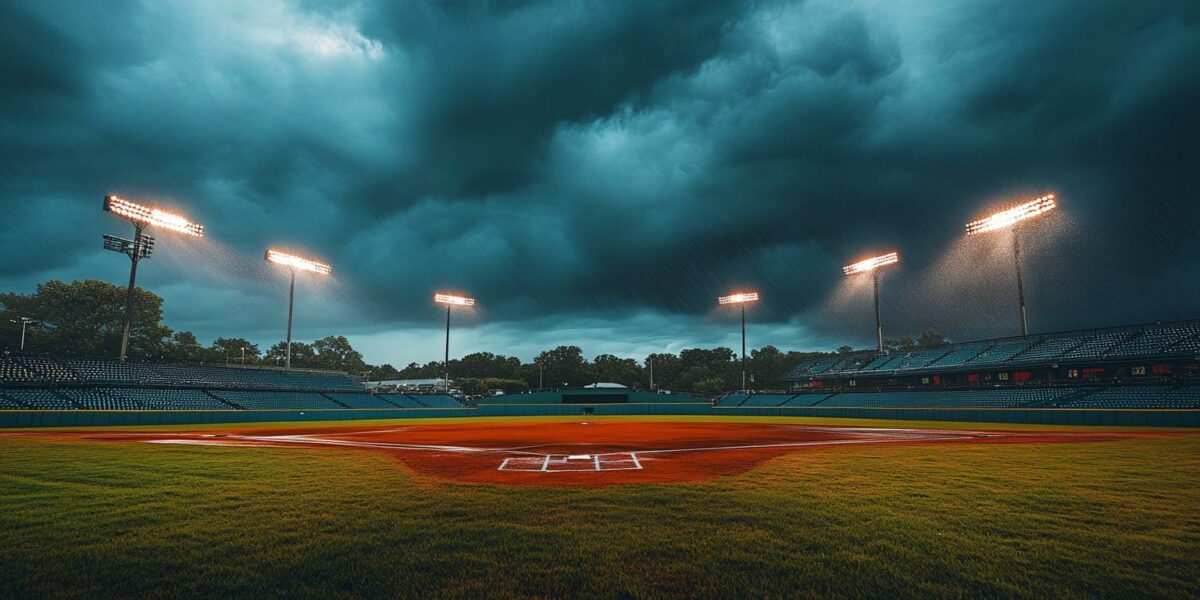Baseball’s Battle with Climate Extremes
The ferocity of Hurricane Milton recently wreaked havoc on South Florida, unroofing Tropicana Field, the home of the Tampa Bay Rays. Built to withstand high winds, this stadium’s roof offered refuge from the relentless summer heat. However, climate change is proving to be a formidable adversary, challenging traditional solutions.
Baseball, among the major sports, uniquely suffers from climate change. Its outdoor nature and lengthy season expose it to the erratic whims of the weather. Rising temperatures and unpredictable storms make games increasingly hazardous, with players like Dylan Bundy succumbing to heat exhaustion on live television.
Wildfire smoke, flooding, and severe storms have disrupted numerous games, forcing the league to adapt. The once rare storms are now an annual affair, as witnessed when a tempest in Atlanta delayed a crucial Mets-Braves game. Such incidents highlight the urgent need for new strategies.
Teams are improvising with misting fans and ice-water containers to combat the heat. Yet, these measures only offer temporary relief. Research indicates that umpires’ decisions falter in extreme heat, and hotter temperatures affect the aerodynamics of baseballs, altering game dynamics.
The Future of Baseball’s Environment
Baseball’s latest season saw the L.A. Dodgers triumph in a city frequently beset by extreme weather. Looking ahead, the sport questions its own survival amidst escalating climate threats. Jessica Murfree, a sport administration expert, warns of an uncertain future if the sport fails to adapt.
In a scene from the science fiction film Interstellar, baseball’s future is depicted as a relic. Students at Florida State University are shown this clip to emphasize the potential decline of even the most prestigious teams, as climate change continues to alter the landscape.
Murfree believes that sports might be among the first aspects to suffer as we surpass climate tipping points. Baseball’s historical openness to the world, celebrated by Walt Whitman’s writings, is now under threat, as the sport grapples with a changing planet.
Key challenges include:
- Increasing temperatures making outdoor games uncomfortable and unsafe.
- Frequent extreme weather causing game delays and cancellations.
- The need for costly stadium renovations to adapt to new climate realities.
A New Era of Stadium Design
The trend toward indoor stadiums, started with the Houston Astrodome, continues as cities face rising temperatures. Tropicana Field and other domed venues offer respite from the elements, but they lack the natural ambiance that defines baseball’s charm.
However, even these structures struggle in extreme conditions. In Phoenix, Chase Field’s air conditioning falters under relentless heat. The challenge lies in balancing tradition with innovation, as teams seek to maintain baseball’s essence while adapting to environmental demands.
Owners and leagues are motivated by financial stakes to keep fans engaged. With billions invested in stadiums, the industry is under pressure to find solutions. Experts propose innovative ideas, from breathable uniforms to strategic stadium locations.
While not all proposals are immediately viable, the sport’s nostalgic nature must yield to practicality. Murfree cautions that clinging to the status quo risks losing what makes baseball beloved. Flexibility is key to preserving the sport’s future.
Baseball’s Evolution Amidst Climate Challenges
Baseball fans romanticize the sport’s history, but change is inevitable. From racial integration to technological advancements, baseball has evolved. Now, faced with climate change, the sport must undergo its most radical transformation yet.
Once played on irregular fields by amateurs, baseball has grown into a global phenomenon. Its journey includes night games, sabermetrics, and the pitch clock. Each innovation met initial resistance but was eventually embraced, highlighting baseball’s resilience.
As the sport faces an unrecognizable future, it must adapt to survive. The choice is stark: embrace change or risk obsolescence. The beauty of baseball, shaped by natural elements, faces its greatest test, and its survival depends on a willingness to evolve.
Without adaptation, baseball risks becoming a relic of the past. Yet, this challenging scenario also presents an opportunity for the sport to redefine itself in the face of immense environmental pressures.



isabelleaurora
Thanks for highlighting the issue. It’s time for baseball to step up its game in sustainability!
stella2
Are there other sports facing similar challenges due to climate change, or is baseball uniquely affected?
Skylar
Why is it taking so long for the sport to adapt to these climate challenges? Seems a bit slow.
Ian
Seems like baseball needs to hit a home run with innovation to tackle these issues. 😉
hudson
This makes me wonder if baseball will look completely different in 50 years. Adapt or lose, huh?
jeremiah
Shouldn’t the league invest more in researching eco-friendly solutions for stadiums?
caroline1
Wow, I never knew climate change could affect baseball so much! Thanks for enlightening us! 😃
SadieEmber
Is there a possibility for baseball games to be played in more indoor arenas to avoid weather disruptions?